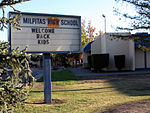Milpitas, California
1954 establishments in CaliforniaCities in Santa Clara County, CaliforniaCities in the San Francisco Bay AreaIncorporated cities and towns in CaliforniaMilpitas, California ... and 5 more
Populated places established in 1852Populated places established in 1954Silicon ValleyUse mdy dates from January 2017Vague or ambiguous time from July 2021

Milpitas (Spanish for "little milpas") is a city in Santa Clara County, California, in Silicon Valley. As of the 2020 census, the city population was 80,273. The city's origins lie in Rancho Milpitas, granted to Californio ranchero José María Alviso in 1835. Milpitas incorporated in 1954 and has since become home to numerous high tech companies, as part of Silicon Valley.
Excerpt from the Wikipedia article Milpitas, California (License: CC BY-SA 3.0, Authors, Images).Milpitas, California
East Calaveras Boulevard, Milpitas
Geographical coordinates (GPS) Address Nearby Places Show on map
Geographical coordinates (GPS)
| Latitude | Longitude |
|---|---|
| N 37.434722222222 ° | E -121.895 ° |
Address
BevMo!
East Calaveras Boulevard 709
95035 Milpitas
California, United States
Open on Google Maps







